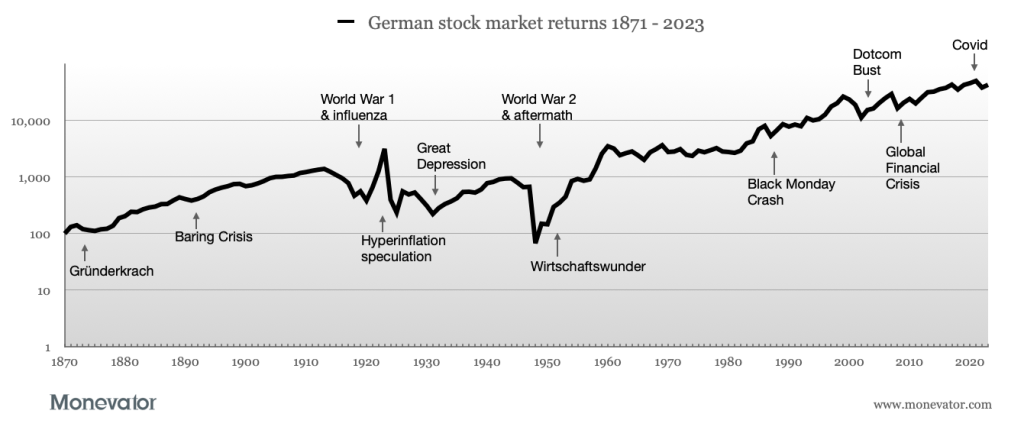
Useful asset classes are low cost, readily understood, easily tradable, and exhibit one or more of the following characteristics:
A long-term track record of delivering positive real returns
Diversifying properties that lower your portfolio’s overall risk
Can protect your wealth during bouts of inflation or deflation
Investable using accessible, liquid, low-cost index-tracking funds or ETFs.
By those criteria, commodities are a shoo-in.
In part one of this series we explained how commodities investing works
In part two we covered commodities’ long-run returns
Now let’s dive into the difference that commodities diversification has made to UK investment portfolios.
Many happy returns
The chart below shows how various 60% equity portfolios performed when diversified with varying commodities allocations. The latter’s share ranges from 0% to 40%:
Data from Summerhaven1, S&P GSCI TR, BCOM TR, JST Macrohistory2, JP Morgan Asset Management, The London Bullion Market Association, Measuring Worth and FTSE Russell. June 2023.
As the cyan line shows, the portfolio without commodities – the regular old 60/40 equities/gilts portfolio – comes dead last. Even more shockingly, the 60/40 equities/commodities portfolio leads the pack.
What gives?
Investing returns sidebar – All returns quoted in this piece are real annualised total returns. That is, they’re the average annual return (accounting for gains and losses) realised in a given time period. These returns include the impact of reinvested dividends and interest, but strip out the vanity growth delivered by inflation that does nothing to boost your actual spending power. Dollar returns for commodities have been converted to GBP.
How an allocation to commodities improves portfolio diversification
The tables below show the difference commodities diversification makes in greater detail for passive investment portfolios.
We look at annual returns from 1934-2022, because this is the longest time period we have investable commodity data for.
60% equity portfolios and commodities diversification
The engine of each portfolio is 60% UK equities. Diversification is provided by various allocations to government bonds (gilts), commodities, cash, and gold, as shown in the next table.
I’ve also included a 100% equities portfolio for comparison. Each portfolio is rebalanced back to its target asset allocations at the end of each year.
60/40 e/b
60/30/10 e/b/c
60/20/20 e/b/c
60/10/10/10/10 e/b/c/ch/g
60/40 e/c
100 e
Annualised return (%)
4
4.6
5.2
4.7
6
5.4
Best return (%)
66.4
61.7
56.9
55.4
47.3
103.4
Worst return (%)
-45.1
-38.7
-32.4
-29.3
-25.6
-57
Volatility (%)
14.8
14
13.7
12.8
14.5
20.7
Sharpe ratio (%)
0.27
0.33
0.38
0.37
0.42
0.26
e = equities, b = bonds, c = commodities, ch = cash, g = gold
The portfolio with the best annualised return is the 60/40 equities/commodities mix. This asset allocation even beats 100% equities into a cocked hat.
Moreover, the 60/40 commodities-diversified portfolio earns a superior return with considerably less whipsaw volatility than its 100% equities rival.
I’ve used the Sharpe ratio to measure the risk/reward trade-off. The higher your Sharpe ratio, the better your risk-adjusted returns. Or, the more return you get per unit of risk as measured by volatility3.
The 60/40 equities/commodities load-out has the highest Sharpe ratio in the table. That makes it the most rational portfolio of the set, if you believe that investors should choose the portfolio which offers the greatest return for a given level of volatility.
The worst return row further demonstrates that high commodities allocations have mitigated some of the UK’s severest investing tests of nerve on record.
Meanwhile the least volatile portfolio also happens to be the most diversified: 10% bonds, 10% commodities, 10% cash, 10% gold.
But that stability was achieved at the expense of return, compared to portfolios with higher commodity allocations.
Curb your enthusiasm
On the face of it, ditching gilts4 for commodities led to a better outcome on every metric: whether that be average returns, volatility, or the Sharpe ratio.
But I’m not selling my bonds yet. I’ll explain why shortly.
It’s also fair to say 100% equities doesn’t look worth the risk. The same would be true if we substituted global returns for the UK stock market, incidentally.5
In contrast, the better diversified 60/20/20 portfolio experiences much lower volatility than 100% equities. And it achieves much the same return.
80% equity portfolios and commodities diversification
80/20 e/b
80/10/10 e/b/c
80/20 e/c
Annualised return (%)
4.7
5.4
5.9
Best return (%)
84.9
80.1
75.4
Worst return (%)
-51
-44.7
-38.4
Volatility (%)
17.6
17
16.7
Sharpe ratio (%)
0.27
0.32
0.36
e = equities, b = bonds, c = commodities
Once again, the key metrics improve as gilts are elbowed out of the portfolio by commodities.
Notice though, that while 80/20 equities/bonds is better than the comparable 60/40 portfolio, 80/20 equities/commodities is worse than 60/40 equities/commodities. Especially in terms of the risk-reward ratio.
The mildly negative correlation between commodities and equities reduces volatility, and also generates a rebalancing bonus.
There was no need to keep upping the equity ante in pursuit of return when commodities were part of your portfolio mix over this particular timeframe.
Intriguingly, commodities’ long-term return was lower than equities from 1934-2022. But the two assets combined, outstripped equities alone.
50% equity portfolios and commodities diversification
50/50 e/b
50/30/20 e/b/c
50/50 e/c
Annualised return (%)
3.5
4.7
6
Best return (%)
57.2
47.6
34.3
Worst return (%)
-42.1
-29.4
-23.9
Volatility (%)
13.7
12.3
14.4
Sharpe ratio (%)
0.26
0.38
0.41
e = equities, b = bonds, c = commodities
The synergism between commodities and equities comes to the fore again with a 50/50 asset allocation.
I have to counsel though that we can’t necessarily expect the two assets to play together quite so nicely in the future. That is why I don’t advocate ditching bonds.
Rounding error fans should note that the 50/50 equities/commodities portfolio actually achieved a 5.96% annualised return versus 6.04% for 60/40 equities/commodities. That’s why the latter portfolio has a slightly higher Sharpe ratio.
Interestingly, the 50/30/20 lock-up delivers the lowest volatility so far, along with a highly respectable annualised return.
But if limiting the downside is your thing, just wait until you see the Permanent Portfolio results.
The Permanent Portfolio, but replacing gold with commodities
25/25/25/25 e/b/ch/g
25/25/25/25 e/b/ch/c
Annualised return (%)
2.6
3.5
Best return (%)
21.2
20.5
Worst return (%)
-11.4
-15.4
Volatility (%)
7.7
8.4
Sharpe ratio (%)
0.34
0.42
e = equities, b = bonds, c = commodities, ch = cash, g = gold
The first column shows the standard Permanent Portfolio formulation of 25% equities / 25% bonds / 25% cash / 25% gold. This all-weather blend is hailed for its low volatility, wealth-preserving qualities. But its low long-term returns make it hard to recommend for most.
Our second column swaps out gold for commodities. Now volatility rises just a smidge, but a significantly higher annualised return helps the portfolio to a 0.42 Sharpe ratio.
That’s the equal of anything else we’ve looked at today. Go tell the gold bugs!
When do commodities work?
The answer to this question explains why I won’t be swapping all my bonds for commodities (although I probably will exchange some).
Commodities have tended to work best during periods of economic expansion and rising inflation. See this table from the research paper Commodities for the Long Run by Levine, Ooi, Richardson, and Sasseville:
Excess returns in USD for an equal-weighted commodities index.
The table also shows that commodities typically underperform in recessionary and falling inflation rate environments.
Note, the table traces broad trends, but it isn’t saying commodities will automatically perform on cue.
For example, commodities added to investor’s woes during the Global Financial Crisis and the Great Depression. But they were a healing balm during the Dotcom Bust and 1972-74 oil shock (the latter a hideous stagflationary amalgam of economic torpor and galloping inflation).
Think different
As passive investors we shouldn’t be tactically trading commodities every time there’s a recession warning. We’re interested in the strategic benefits each asset class can bring to our portfolio.
So it’s good to know that the findings above are also confirmed by other researchers who’ve investigated long-term commodity returns. These include Bhardwaj, Rajkumar, and Rouwenhorst (see The Commodity Futures Risk Premium: 1871–2018), and Dimson, Marsh, and Staunton (see the Credit Suisse Global Investment Returns Yearbook 2023).
To that we can add Monevator’s findings about the unpredictable performance of diversifiers in UK investment portfolios in part two of this series.
On that measure, commodities improved portfolio outcomes 58% of the time when equities retreated, but actually made matters worse in 42% of downturns.
To sum up our diversification dilemma: government bonds defend against recessions. Commodities typically don’t.
And commodities are a partial hedge against inflation, whereas nominal bonds most definitely are not.
That’s why I want both asset classes in my portfolio.
What should my commodities asset allocation be?
Now you’re asking.
The optimal asset allocation can only be known in retrospect, because it’s dependent on unknowable variables.
Think future returns, the future correlation of asset class returns, and your particular blend of assets.
Various sources offer a future expected excess return for commodities of 3%, so we might expect a 3.5% to 4% total return.
But expected returns are to be taken with a pinch of salt.
Dimson, Marsh, and Staunton explain why nailing the right asset allocation is like trying to pin the tail on a donkey:
The optimal allocation to futures depends on the investor’s tolerance for risk. For an investor who was comfortable with the risk of a 60:40 equity: bond portfolio, they [Erb and Harvey] show that the optimal allocation would be 18% in commodity futures, 60% in stocks and 22% in bonds. Unsurprisingly, the optimal allocation to futures depended on the expected excess returns. With an expected excess return of 1%, the optimal allocation to futures fell to 3%.
Vanguard’s take is that a future optimal commodities asset allocation could lie anywhere from 0% to 15%. That’s according to its paper Commodity Investing and its Role in a Portfolio.
But Vanguard’s base case scenario suggests an allocation to commodities of less than 5%, which is almost as good as saying: “don’t bother.”
Stock puppets
At this point, you might be throwing up tour hands and thinking, “I’ll just get my commodities exposure through commodity stocks.”
Sadly, Dimson, Marsh, and Stauton cite evidence that this won’t work:
…investors may also gain exposure to commodities through their equity investments, e.g. in mining, energy and agriculture-related stocks. GR [Gorton and Rouwenhorst] investigated this by comparing the performance of commodity futures with commodity company stocks. They concluded that the latter behaved more like other stocks than futures. They were not a close substitute.
Commodity of errors
As you can probably tell, there’s no right answer. But returning to our original criteria for an investable asset class, let’s review the positive case for commodities:
A long-term track record of delivering positive real returns? Yes!
Diversifying properties that lower your portfolio’s risk? Yes!
Can protect your wealth during bouts of inflation or deflation? Inflation, sometimes
Investable using accessible, liquid, low-cost index-tracking funds or ETFs? Yes!
The fail for broad commodities ETFs is they are not readily understood (albeit you could argue the same is true for bonds and gold).
On those grounds, plus the imperative to keep things as simple as possible – but no simpler – I wouldn’t blame anyone for saying, “Thanks, but no thanks,” to commodities.
However, for an engaged passive investor like myself, I believe the case for commodities is compelling. Assuming I can find the right passive fund to invest in, of course. I’ll report back on this in part five of our series.
But none of this means I won’t be unlucky. The optimal allocation to commodities could be zero during my investing lifetime. But I can only know that after the fact. That’s investing risk for you.
Coming around to commodities
Here’s where I am at…
Equities have a higher long-run risk premium than commodities and so should be the portfolio mainstay.
There’s a clear rationale for why commodities should be able to deliver a reasonable rate of return in the future, but nothing is guaranteed.
Commodities are an attractive strategic diversifier due to their historically low correlation with equities and bonds.
The limits of a vanilla 60/40 portfolio were hammered home as if by a hammer-wielding maniac by the events of 2022. And we’ve previously deep-dived the benefits of a more diversified portfolio.
I’m particularly keen on not being solely dependent on my bonds for diversification – just in case we’re on the wrong end of a rising interest rates bond super-cycle.
I’d also like to be less reliant on equities for growth. Multi-decade bear markets can affect this asset class, too.
So the fact that commodities deliver good long-term returns and offer some insulation from inflation is another big tick for me.
I’m also a fan of owning every useful asset class in reasonable amounts.
Less than 10% in commodities appears to me next to irrelevant, but I don’t think I’m brave enough to own 20%.
I haven’t fully made up my mind yet. It’ll depend on how convincing I find the available broad commodities ETFs once I’ve completed my research into those.
Either way, I’ll probably ease my way into commodities slowly. Perhaps 5% of the portfolio at a time, over the course of a year or so.
In the meantime, I want to dig into how well commodities stack up as an inflation hedge for UK investors. So that’s coming next in the series. (Subscribe to ensure you see it.)
Take it steady,
The Accumulator
Bhardwaj, Geetesh and Janardanan, Rajkumar and Rouwenhorst, K. Geert, “The First Commodity Futures Index of 1933,” Journal of Commodity Markets, 2020.Òscar Jordà, Katharina Knoll, Dmitry Kuvshinov, Moritz Schularick, and Alan M. Taylor. 2019. “The Rate of Return on Everything, 1870–2015.” Quarterly Journal of Economics, 134(3), 1225-1298.i.e. annualised standard deviationUK government bonds.We can’t get global equity returns before 1970. And the UK stock market’s longer track record enables our comparison to encompass a wider range of economic conditions. But UK returns are broadly in line with global returns and are probably a better benchmark than exceptional US returns that may not be repeated in the future.
The post Commodities diversification: is it worthwhile? appeared first on Monevator.



